- Bernard Preston homepage
- Woodstove
- Woodstoves
Woodstoves
Woodstoves today are a whole different kettle of fish compared to what we were brought up with; they were often dirty, smelly and hard to light; and would produce a prodigious quantity of smoke which in reality is unburned-fuel. Consequently many towns would ban them for environmental reasons.
These modern ones are already producing heat in two minutes, literally, and in five you can't touch the flue; that is where most of the warmth comes from. They bring instant comfort to those chilled-feet.
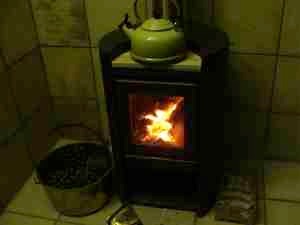
This page was last updated by Bernard Preston on 28th February, 2023.
My first was a Rayburn; it looked beautiful in burnished bronze but it was a beast to light. Eventually we dumped it. In retrospect I realised the bent and too short chimney was probably the cause; straight and long is the answer.
The modern woodstove has a built in second chamber; the hot unburned gases are fed back into the main part where all the logs are located. In short, they are turboed. Fanned by the preheated exhaust, the flames take off.
Just as important, any unburned gases are reignited with the result that these super-efficient woodstoves produce very little smoke. They are environmentally friendly.
Be a little smarter than we were with that old Rayburn; decide what you want of your stove.
Another decision is whether to have mild steel, or caste iron? We started with the former, and then our daughter put in the latter. Frankly I have little preference; they both work well.
Here are a few questions you should first be considering.
- Heat a kettle?
- Cook your dinner?
- Burn all day and night, or just for a short time?
- What size door you do want?
- Heat water for your bath?
The caste-iron stoves are much heavier and can crack if dropped on installation, but that's unlikely. They take a little longer to get hot, but retain the heat for longer.
As much of the heat is produced by the flue which is identical in both, they heat the room in a very short time.
Woodstoves
If you want your woodstoves to burn slowly for a long time, then it's best use one whole, unsplit log; it takes a little longer to get them burning but for hours they release their warmth. The pin oak that recently came down in a storm is perfect.
For instant, high temperature, then split logs grown from a soft wood are better; together with plenty of kindling. If you want hot water for coffee in ten minutes, for example.
Best for me, is a combination of both hard and soft woods on hand, some split, others whole; then you can select for your particular needs for today.
Door size
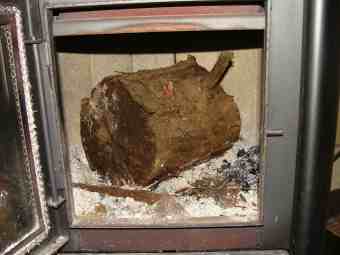
The door size is an important factor; choose a wide one. Remember, if you need short logs, you'll probably pay more per cord; and if you are processing your own timber, it means more cuts with the chainsaw. In general, buy woodstoves with as big an opening as you can find. Ours above is a trifle too narrow.
Our daughter chose a stove with a wider door size, so they get the longer logs.
If you want the stove to burn slowly, and for a long time, then put in a whole, unsplit log.
Then you'll need some kindling preferably from a soft wood; we just use twigs from the garden, but perhaps you will have to split a log with an axe. That is a chore.
Loosely crumpled newspaper, a few pieces of cardboard or egg-boxes make up the rest; and one match. That's all it takes with these modern woodstoves; they sound like a Boeing on takeoff within minutes.
If you're a carpenter then a few offcuts from the workshop will always help; usually that will be a hardwood that will burn slowly. You can even use some coarse sawdust from the thicknesser.
Keep everything loose for maximum air. If you crumple and stuff it too tightly, you'll have more trouble getting it burning. Newspaper and cardboard go at the bottom, followed by the twigs and then a few larger pieces.
Your stove will have a damper to control the air; open it all the way for maximum draft.
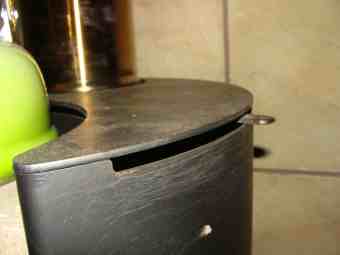
Lightly crumpled newspaper, bits of cardboard, twigs and a few larger branches are all that are needed to start your fire.
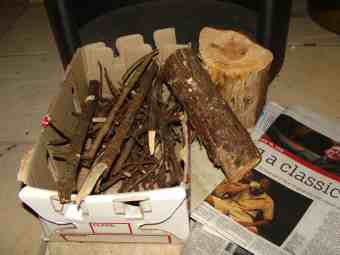
A few offcuts from your carpentry make great firewood, and any coarse sawdust from the saws and planers will help.
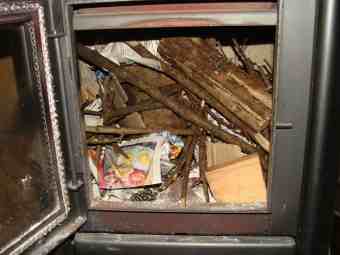
One match, and this is what it looks like after a minute; you can already feel the warmth.
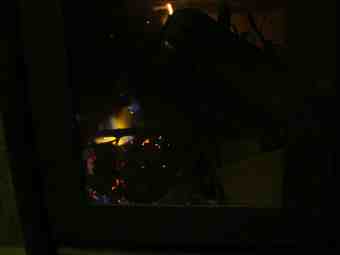
And this is after three minutes; already the flue is too hot to touch.
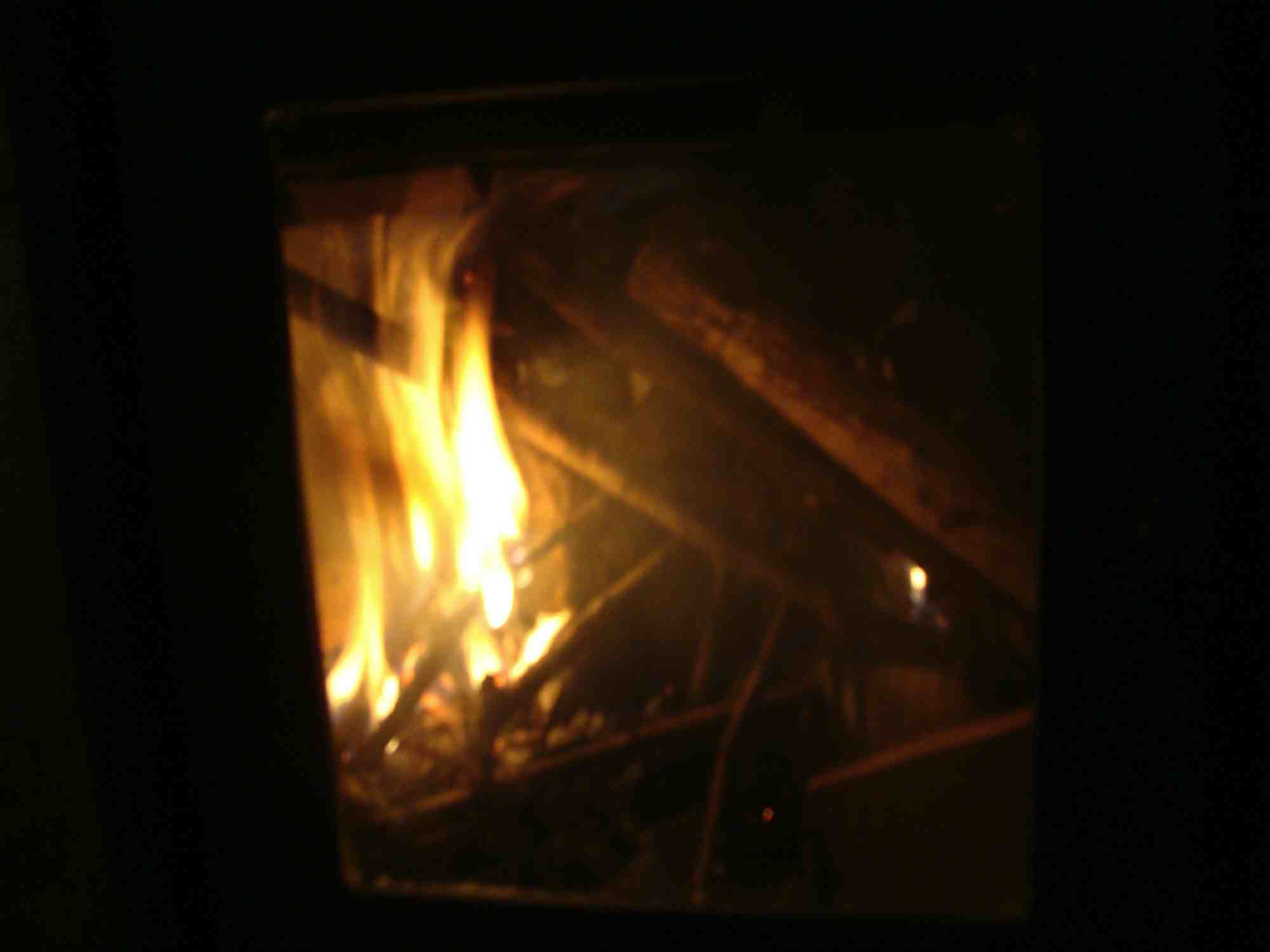
After ten minutes it's burning fiercely, the flue is beginning to glow and it is already time to start closing the damper; you do not want it to get too hot.
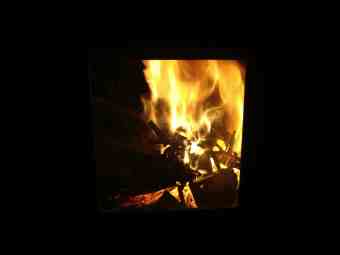
Flue
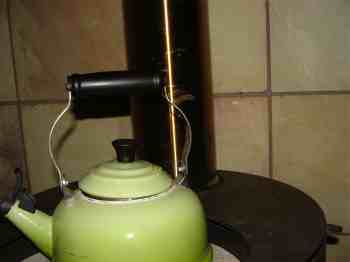
The woodstove flue should only be made of stainless steel; it's expensive, but the mild kind will not stand up to the corrosive acids in the gases.
Otherwise you'll have to replace your flue within about five years; if you do it right the first time, then it hurts only once.
Should you have a double story house then make sure your woodstove flue goes through the floor and then passes via the bedroom above; it will keep you warm all night.
It should extend beyond the highest point of the roof.
One question you'll have to face squarely is how big your woodstove should be? If you have a well insulated home, then purchase one smaller than recommended; if it is drafty then get a large model.
Some people recommend a double flue, two concentric tubes with insulation between them. In my opinion that's necessary only where the chimney is passing through the ceiling and roof, near to sensitive and flammable materials like wood and electrical conduit.
Most of the heat comes from the flue itself, so an insulated tube means most of the warmth goes up the chimney.
We have insulated walls, double glazing and polystyrene in the ceiling; this tiny stove is more than adequate for the large living room area and inter-leading kitchen.
It heats the whole area, and funnels up the stairs to the rooms above; but then it only gets below freezing at night in South Africa. Even on cold days it's rarely below ten. In Chicago I would buy a larger woodstove.
We have had trouble with a smoky smell, that of a khaya in South African parlance; a mud hut with a fireplace in the centre. At first we were anxious that roofing timbers were being charred, but impossible with double insulated flue in the ceiling, and no smell up there.
It was smoke coming in through the window, so we simple recommending closing them when lighting woodstoves.
The installing company said it was a dirty flue, but cleaning didn't help at all; it took us six years to work that out.
Hot water
A hot water kettle lives permanently on our woodstove in the winter. Once the fire is burning fiercely it boils very quickly; it's also a help to moisturise the air.
Obviously if you're a greenie like me, you will be pleased that your electrical bill is lower, as is your carbon footprint.
Cooking
You can heat food on a woodstove, of course, but we don't generally cook anything; it makes unpleasant odours in the living room.
And you really don't want to cook in the lounge in the summer; it's far too hot. Rather build and use a solar electric oven, and an induction cooktop stove for your needs.
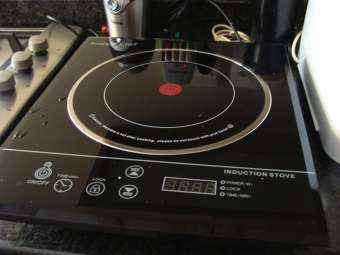
This inexpensive tabletop model uses half the electricity, and cooks twice as fast as any other stove; we use it almost exclusively. It's so user-friendly.
Removing the ash
Removing the ash is one of the joys of a modern woodstove; there is almost none. A small shovel and a container is all you need, and it only needs to be done every couple weeks.
No more carting a heavy grate outside is required for removing the ash, and slipping a disc.
The ash incidentally is quite alkaline; don't put it on your compost heap. Either sprinkle it around your plants or, should you be into a doggy poo worm farm, then it is perfect for counteracting any acidity.
Commercial firewood splitter
If you are going to have a woodstove, then obviously you need timber. For thousands of years logs have been divided using an axe of sorts; it's hard work and not without its dangers.
A commercial firewood splitter takes a lot of the strain off your body.
Notice the backyard permaculture philosophy at work. Using a tree planting help guide you get as many in the ground as possible; some for show, others for fruit and for firewood.
Using a chainsaw and commercial firewood splitter you prepare the logs for the stove; the ash, unlike that from coal which is toxic, goes back to fertilise your vegetables and fruit trees.
And finally I'm ending with a small warning. I have used this splitter for five years, but recently had to saw down a very hardwood Honey Locust tree. Parting the very large diameter logs is dangerous, even if they are 10cm thick. I have ceased and instead saw them into halves, having had a few grazes and near misses.
“There are
two spiritual dangers in not owning a farm. One is
supposing that breakfast comes from the grocery, and the other that heat
comes from the furnace.”
Aldo Leopold
Bernard Preston
Bernard Preston and his wife are greenies, engrossed with making sure they leave their grandchildren with a habitable planet. Can we give them any other legacy? Trees in essence are a wonderful creation on how to capture the power from the sun. We can utilize that energy in our woodstoves, making sure of course that we plant another sapling.
Do you need tree planting help? This is mostly about fruit but the principle is the same.
Chopping down trees has its downside, obviously, but most of the wood we burn comes from our own garden; those that either fall down or need to be pollarded.
Well, just recently a huge tree in the street was blown over; since it lay on public property and was simply a nuisance to all and sundry, I gladly used the chainsaw and commercial firewood splitter so we had more fuel for our woodstoves.
Powered by the energy from the sun, this splitter cost nothing to use; an electrical chainsaw is next in the planning.
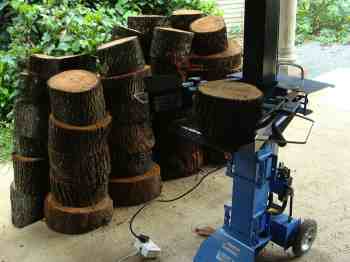
Useful links
When browsing use right click and Open Link in New Tab, or you may get a bad gateway signal.
Newsletter
Our newsletter is entitled "create a cyan zone" at your home, preserving both yourself and Mother Earth for future generations; and your family too, of course. We promise not to spam you with daily emails promoting various products. You may get an occasional nudge to buy one of my books.
Here are the back issues.
- Investing in long-term health
- Diseases from plastic exposure
- Intensive lifestyle management for obesity has limited value
- A world largely devoid of Parkinson's Disease
- The impact of friendly bacteria in the tum on the prevention of cancer
- There's a hole in the bucket
- Everyone is talking about weight loss drugs
- Pull the sweet tooth
- If you suffer from heartburn plant a susu
- Refined maize meal and stunting
- Should agriculture and industry get priority for water and electricity?
- Nature is calling
- Mill your own flour
- Bake your own sourdough bread
- Microplastics from our water
- Alternative types of water storage
- Wear your clothes out
- Comfort foods
- Create a bee-friendly environment
- Go to bed slightly hungry
- Keep bees
- Blue zone folk are religious
- Reduce plastic waste
- Family is important
- What can go in compost?
- Grow broad beans for longevity
- Harvest and store sunshine
- Blue zone exercise
- Harvest and store your rainwater
- Create a cyan zone at your home
Did you find this page interesting? How about forwarding it to a friend, or book and food junkie? Better still, a social mead tick would help.
- Bernard Preston homepage
- Woodstove
- Woodstoves
Address:
56 Groenekloof Rd,
Hilton, KZN
South Africa
Website:
https://www.bernard-preston.com